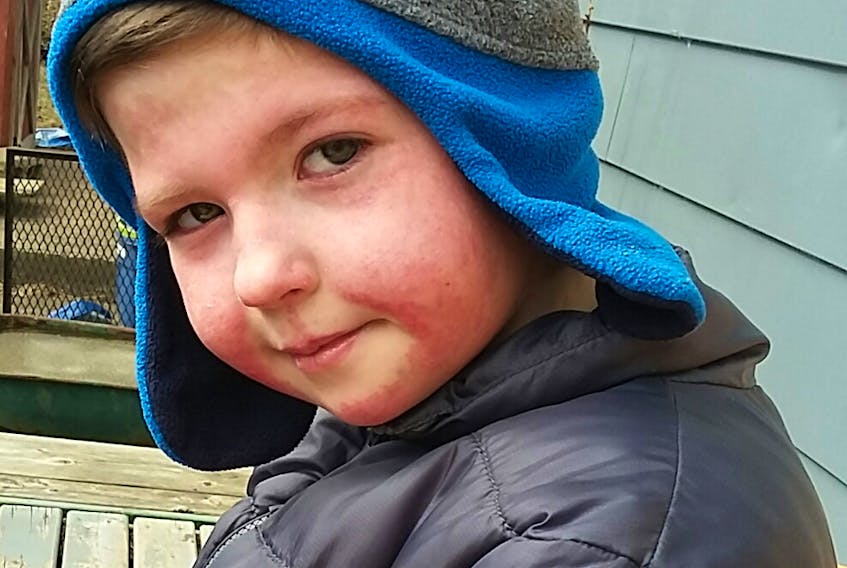In the evening of April 19 John and Amber Guthro received an alarming phone call concerning their five-year-old son, Jack.
“I guess because of the joint pain we thought he might have arthritis, but he also had a rash so we weren’t really sure what was going on. We just knew that they sounded really urgent,” said Amber Guthro.
Joint pain, a nasty rash on his cheeks, and a level of lethargy that would concern any parent of a preschooler, were all symptoms that caused them to reach out to their family doctor.
“He was initially diagnosed with Fifth’s Disease,” said Guthro, referring to a fairly common childhood illness which usually clears up within weeks. But it didn’t.
“Instead of getting better, the joint pain was getting worse. He couldn’t even get out of bed in the morning. We had to carry him out of bed.”
The Guthros were referred to a pediatrician who took a sample of Jack’s blood on April 19. At 8 p.m. that night they received the telephone call.
“They called and said to go to the IWK first thing in the morning.”
Jack would end up staying at the Halifax IWK for the next 23 days.
Blood work
“He had a bone marrow test, heart scans, kidney biopsies, blood work, blood work, and blood work,” added Amber. “They thought he had tuberculosis, they tested him for HIV, and asked if we had recently travelled outside the country,” his father John added.
After all the tests were done Jack’s diagnosis emerged, and the results were surprising even to the team of doctors who worked with him.
“The craziest thing was that the doctor came in and was like ‘we’ve been reading all about you Jack, this is very fascinating,” recalls John.
Jack was diagnosed with Lupus.

A disease with 1,000 faces
Lupus is an autoimmune disease which attacks the tissues and organs in the body of the person who has it. It is a chronic disease, so it persists for a long time and cannot be prevented through vaccination or easily cured with medication. Instead, medication is used to treat the illness, making it more manageable, and improve the quality of life for those affected by this disease.
The reason why Jack’s diagnosis came as a surprise to everyone is because Lupus tends to be more frequent in individuals between 15 and 45, and, according to Lupus Canada’s website, is diagnosed in women nine-times more often than in men.
“Typically, people think of those affected by lupus as women in their childbearing years, but we’re seeing more and more people being diagnosed with Lupus,” said Lupus Canada’s executive director, Leanne Mielczarek.
Lupus Canada is an organization which wants to increase people’s knowledge about the disease and to advocate for those the people who live with it. Lupus has traditionally been misunderstood and confused with other diseases. Because of this, people may be treated for diseases with similar symptoms while the real culprit goes under the radar.
What’s more, since Lupus is a systemic disease capable of affecting any organ or tissue in the body, the symptoms will often vary depending both on part of the body being affected, and on the individual person being affected by it.
It can affect anyone at anytime, and in any organ. We refer to Lupus as a disease with 1,000 faces,” said Mielczarek in a phone interview. “How it looks from person to person can be different, which makes diagnosis and treatment trickier.”
Jack’s treatment had to be carefully determined. He was given high doses of the steroid prednisone in order to reduce the inflammation in his joints and to temper the autoimmimune activity in his system resulting from the disease. Over the last few months the dosage has been gradually reduced.
“We’re finally down to 7.5 milligrams, and next week he’ll be down to 5,” said Amber. “They’re doing 2.5 at a time, and every time they drop it down he has a bit more pain.”
The synthetic steroid is there to bolster what Jack’s body produces naturally, and so he feels the lack of it when the dose drops and while he waits for his body to catch up.
Today the whole family is back in their New Glasgow home, and Jack runs the length of the living room before jumping onto a couch like a gymnast testing out a new crash-pad. He has band aids on both shoulders from the flu shots that he received that morning.

He’s used to needles by now, and he shows off the fresh band aids by flexing his biceps.
Five-year-old’s face on a national campaign
Recently, Jack’s parents received another message. Again, it was about Jack, but the tone was considerably lighter.
In an email to the Guthros Lupus Canada asked if Jack would be the face of their holiday fundraising campaign. His parents asked him, and Jack gave the thumbs up.
People wishing to contribute toward research aimed at improving the understanding of Lupus and in its treatment, can do so online at www.lupuscanada.org/directmail .









